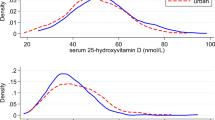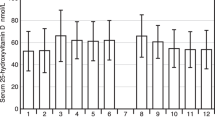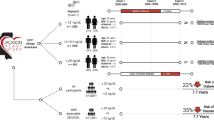Abstract
Background/Objectives:
The long-term chronology of the association between low serum concentrations of 25-hydroxy vitamin D (25(OH)D) and weight status is unclear. We examined whether lower 25(OH)D in middle-aged women drives upwards the weight, body mass index (BMI) and waist–hip ratio (WHR) over the next 32 years, and whether higher 25(OH)D might predict less decline in the mid- to late-life height trajectory.
Subjects/Methods:
The Population Study of Women in Gothenburg started in 1968–1969 (the baseline) in 38–60-year-old women residing in Gothenburg, Sweden. Anthropometric measures were taken at baseline and 4 re-examinations until 2000–2003. Levels of 25(OH)D were analyzed in serum stored since baseline in 1227 (84%) women. Repeated measures analyses were used to model associations between 25(OH)D (dichotomized, cut point 51.45 nmol/l) at baseline and anthropometric trajectories, adjusting for fixed and time-dependent covariates.
Results:
At baseline, mean BMI was 25.2 kg/m2 in women with low 25(OH)D and 23.8 kg/m2 in the remaining women (P<0.001), but this difference did not increase over 32 years and longitudinal differences were explained by the baseline BMI. Similar results were observed for weight and WHR. In contrast, no association was seen for height at baseline or longitudinally.
Conclusions:
No relationship was observed between 25(OH)D height trajectory, but lower 25(OH)D was associated with higher BMI, weight and WHR differences that were maintained over three decades. This provides no evidence for the direction of causality, but for a life-long difference in adiposity-related measures according to the 25D level in middle-aged women.
This is a preview of subscription content, access via your institution
Access options
Subscribe to this journal
Receive 12 print issues and online access
$259.00 per year
only $21.58 per issue
Buy this article
- Purchase on Springer Link
- Instant access to full article PDF
Prices may be subject to local taxes which are calculated during checkout


Similar content being viewed by others
References
Pereira-Santos M, Costa PR, Assis AM, Santos CA, Santos DB . Obesity and vitamin D deficiency: a systematic review and meta-analysis. Obes Rev 2015; 16: 341–349.
Saneei P, Salehi-Abargouei A, Esmaillzadeh A . Serum 25-hydroxy vitamin D levels in relation to body mass index: a systematic review and meta-analysis. Obes Rev 2013; 14: 393–404.
Earthman CP, Beckman LM, Masodkar K, Sibley SD . The link between obesity and low circulating 25-hydroxyvitamin D concentrations: considerations and implications. Int J Obes (Lond) 2012; 36: 387–396.
Mutt SJ, Hypponen E, Saarnio J, Jarvelin MR, Herzig KH . Vitamin D and adipose tissue–more than storage. Front Physiol 2014; 5: 228.
Ding C, Parameswaran V, Blizzard L, Burgess J, Jones G . Not a simple fat-soluble vitamin: changes in serum 25-(OH)D levels are predicted by adiposity and adipocytokines in older adults. J Intern Med 2010; 268: 501–510.
Jorde R, Sneve M, Emaus N, Figenschau Y, Grimnes G . Cross-sectional and longitudinal relation between serum 25-hydroxyvitamin D and body mass index: the Tromso study. Eur J Nutr 2010; 49: 401–407.
Jamal-Allial A, Griffith JL, Tucker KL . The longitudinal association of vitamin D serum concentrations & adiposity phenotype. J Steroid Biochem Mol Biol 2014; 144PA: 185–188.
Mai XM, Chen Y, Camargo CA Jr, Langhammer A . Cross-sectional and prospective cohort study of serum 25-hydroxyvitamin D level and obesity in adults: the HUNT study. Am J Epidemiol 2012; 175: 1029–1036.
Gonzalez-Molero I, Rojo-Martinez G, Morcillo S, Gutierrez C, Rubio E, Perez-Valero V et al. Hypovitaminosis D and incidence of obesity: a prospective study. Eur J Clin Nutr 2013; 67: 680–682.
Young KA, Engelman CD, Langefeld CD, Hairston KG, Haffner SM, Bryer-Ash M et al. Association of plasma vitamin D levels with adiposity in Hispanic and African Americans. J Clin Endocrinol Metab 2009; 94: 3306–3313.
Fang Y, van Meurs JB, Rivadeneira F, van Schoor NM, van Leeuwen JP, Lips P et al. Vitamin D receptor gene haplotype is associated with body height and bone size. J Clin Endocrinol Metab 2007; 92: 1491–1501.
Jorde R, Svartberg J, Joakimsen RM, Grimnes G . Associations between polymorphisms related to calcium metabolism and human height: the Tromso Study. Ann Hum Genet 2012; 76: 200–210.
Sorkin JD, Muller DC, Andres R . Longitudinal change in the heights of men and women: consequential effects on body mass index. Epidemiol Rev 1999; 21: 247–260.
Bengtsson C, Blohme G, Hallberg L, Hallstrom T, Isaksson B, Korsan-Bengtsen K et al. The study of women in Gothenburg 1968–1969—a population study. General design, purpose and sampling results. Acta Med Scand 1973; 193: 311–318.
Bengtsson C, Hallberg L, Hallstrom T, Hultborn A, Isaksson B, Lennartsson J et al. The population study of women in Goteborg 1974–1975—the second phase of a longitudinal study. General design, purpose and sampling results. Scand J Soc Med 1978; 6: 49–54.
Bengtsson C, Gredmark T, Hallberg L, Hallstrom T, Isaksson B, Lapidus L et al. The population study of women in Gothenburg 1980–1981—the third phase of a longitudinal study. Comparison between participants and non-participants. Scand J Soc Med 1989; 17: 141–145.
Bengtsson C, Ahlqwist M, Andersson K, Bjorkelund C, Lissner L, Soderstrom M . The Prospective Population Study of Women in Gothenburg, Sweden, 1968–69 to 1992–93. A 24-year follow-up study with special reference to participation, representativeness, and mortality. Scand J Prim Health Care 1997; 15: 214–219.
Lissner L, Skoog I, Andersson K, Beckman N, Sundh V, Waern M et al. Participation bias in longitudinal studies: experience from the Population Study of Women in Gothenburg, Sweden. Scand J Prim Health Care 2003; 21: 242–247.
Leu M, Mehlig K, Hunsberger M, Torinsson Naluai Å, Blennow K, Zetterberg H et al. Quality assessment of 25(OH)D, insulin, total cholesterol, triglycerides, and potassium in 40-year-old frozen serum. Epidemiol Res Int 2015; 2015: 581206.
Lapidus L, Bengtsson C, Larsson B, Pennert K, Rybo E, Sjostrom L Distribution of adipose tissue and risk of cardiovascular disease and death: a 12 year follow up of participants in the population study of women in Gothenburg, Sweden Br Med J (Clin Res Ed) 1984; 289: 1257–1261.
Liberatos P, Link BG, Kelsey JL . The measurement of social class in epidemiology. Epidemiol Rev 1988; 10: 87–121.
Vimaleswaran KS, Berry DJ, Lu C, Tikkanen E, Pilz S, Hiraki LT et al. Causal relationship between obesity and vitamin D status: bi-directional Mendelian randomization analysis of multiple cohorts. PLoS Med 2013; 10: e1001383.
Pathak K, Soares MJ, Calton EK, Zhao Y, Hallett J . Vitamin D supplementation and body weight status: a systematic review and meta-analysis of randomized controlled trials. Obes Rev 2014; 15: 528–537.
Mora N, Rieke K, Plitcha J, Segura A, Leehey D, DeShong K et al. 25-Hydroxyvitamin D supplementation and BMI change: a meta-analysis of randomized controlled trials. J Obes Weight Loss Ther 2013; 3: 4.
Gillie O . Controlled trials of vitamin D, causality and type 2 statistical error. Public Health Nutr 2014; 19: 409–414.
Bischoff-Ferrari HA, Giovannucci E, Willett WC, Dietrich T, Dawson-Hughes B . Estimation of optimal serum concentrations of 25-hydroxyvitamin D for multiple health outcomes. Am J Clin Nutr 2006; 84: 18–28.
Pazaitou-Panayiotou K, Papapetrou PD, Chrisoulidou A, Konstantinidou S, Doumala E, Georgiou E et al. Height, whole body surface area, gender, working outdoors, and sunbathing in previous summer are important determinants of serum 25-hydroxyvitamin D levels. Exp Clin Endocrinol Diabetes 2012; 120: 14–22.
Lucas RM, Ponsonby AL, Dear K, Valery PC, Taylor B, van der Mei I et al. Vitamin D status: multifactorial contribution of environment, genes and other factors in healthy Australian adults across a latitude gradient. J Steroid Biochem Mol Biol 2013; 136: 300–308.
Theodoratou E, Tzoulaki I, Zgaga L, Ioannidis JP . Vitamin D and multiple health outcomes: umbrella review of systematic reviews and meta-analyses of observational studies and randomised trials. BMJ 2014; 348: g2035.
Thuesen B, Husemoen L, Fenger M, Jakobsen J, Schwarz P, Toft U et al. Determinants of vitamin D status in a general population of Danish adults. Bone 2012; 50: 605–610.
Leu M, Giovannucci E . Vitamin D: epidemiology of cardiovascular risks and events. Best Pract Res Clin Endocrinol Metab 2011; 25: 633–646.
Souberbielle JC, Body JJ, Lappe JM, Plebani M, Shoenfeld Y, Wang TJ et al. Vitamin D and musculoskeletal health, cardiovascular disease, autoimmunity and cancer: recommendations for clinical practice. Autoimmun Rev 2010; 9: 709–715.
Acknowledgements
Research relating to this article was funded by the FORTE Research Center EpiLife, the Swedish Research Council and the International Guest Researcher Program at the Institute of Medicine, Sahlgrenska Academy, University of Gothenburg, Sweden, and University of Tampere, Finland.
Author information
Authors and Affiliations
Corresponding author
Ethics declarations
Competing interests
The authors declare no conflict of interest.
Rights and permissions
About this article
Cite this article
Lehtinen-Jacks, S., Leu Agelii, M., Hunsberger, M. et al. Serum 25-hydroxy vitamin D levels in middle-aged women in relationship to adiposity and height trajectories over three decades. Eur J Clin Nutr 70, 709–714 (2016). https://doi.org/10.1038/ejcn.2016.11
Received:
Revised:
Accepted:
Published:
Issue Date:
DOI: https://doi.org/10.1038/ejcn.2016.11
This article is cited by
-
Nutritional indicators and metabolic alterations in outpatients with anorexia nervosa: a retrospective study
Eating and Weight Disorders - Studies on Anorexia, Bulimia and Obesity (2021)



